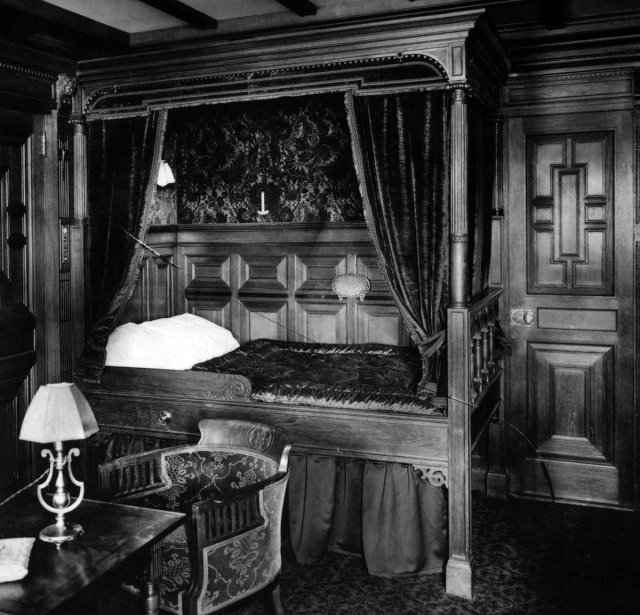
A case of the unspeakable, to paraphrase Oscar Wilde, in pursuit of the unsinkable? It is actually rather fitting that the multi-billionaire mining “magnate” Clive Palmer should be drawn to the idea of recreating the ghastly Titanic experience.
After all, the great passenger liner that sank one hundred years ago aptly symbolises the kind of society that he and his kind feel most comfortable with — a society where the pampered rich have endless opportunities for indulgence while the working poor travel below deck without access to lifeboats, let alone a decently-appointed dining room.
The Edwardian era was largely defined by the stratification of society into three main classes: upper, middle and lower, with various shadings and subtle gradations in between.
Those at the top lived lives of cosseted luxury, while the vast multitudes of the “lower orders” struggled to survive from day to day with no decent education, no job security, no publicly funded health care and no welfare support network.
Although they technically belonged to the same country, the prospects of the English upper and lower classes were so different that they might as well have lived in different universes.
Life expectancy gaps were measured in decades and other comparable indexes of social inequality were off the scale. It was the same in the United States, where the industrial plutocrats of the Gilded Age stalked a virgin capitalist jungle in which only the strong survived.
The stark inequalities of 1912 were reflected in the very design of the Titanic.
Conditions in First Class were the last word in spacious, hand-crafted elegance. It was a different story below decks, where Third Class passengers occupied communal spaces that were dark, cramped and, from a First Class perspective, quite appropriate for the lower orders.
It is true that steerage conditions on the Titanic were marginally better than on many contemporary vessels. Yet it can also be argued that the relative disparity between First and Third Class accommodation was much greater.
When the ship was being built and the lifeboat question came up, a decision was very deliberately made by J.P. Morgan’s White Star Line manager J. Bruce Ismay to cut back to make the First Class promenade areas more aesthetically pleasing.
In any case, English maritime law did not at that stage compel ship owners to provide enough life boats for all the passengers. Oh, for the good old days before the morale-sapping nanny state.
When the ship struck an iceberg on the night of April 14, 1912, and started to founder, the unspoken segregationist assumptions that underlay the Edwardian class system came instinctively to the fore.
The drama that usually took a lifetime to play out, the drama that reserved life’s opportunities for the privileged few at the expense of the exploited majority, was condensed into a few tragic and injustice-filled hours.
With the ship taking water fast, access to lifeboats became a question of life and death — and access to the limited stock of lifeboats was determined, above all, by a passenger’s class.
Of the 2200 passengers aboard, more than 1500 perished. Yet 62% of First Class managed to survive. In Second Class, 43% survived. Shockingly, only a quarter of the Third Class contingent survived, a statistic that tells its own story. Death rates in Third Class were even higher among the many non-English speaking passengers.
For example, not a single one of the ship’s Bulgarian immigrants bound for the US survived.
The nature of the class system even showed up in the relative “dignity” of a passenger’s death. In First Class, you were able to choose if you lived or died. It is true that many male passengers, in keeping with the “chivalrous” standards of the day, allowed women and children to board lifeboats first.
One celebrated couple, the department-store owning Strauses, decided to die together, stoically awaiting their fate rather than be separated.
These stories are touching, but they obscure the fact that the same level of “dignified” choice was not offered to steerage passengers. The decision that they had to die was made for them.
The testimony of one First Class survivor, Colonel Archibald Gracie, vividly supports the claim that working class passengers were kept away from the lifeboat areas until the last moments: “There arose before us from the decks below a mass of humanity several lines deep converging on the Boat Deck facing us … There were women in the crowd as well as men and these seemed to be steerage passengers who had just come up from the decks below.”
By this stage, the ship was in its death throes and there was virtually no hope of rescue for anyone left aboard. A few, like Gracie, were flung into the water near an upturned lifeboat, which they commandeered. The rest drowned or froze.
In the aftermath, contemporary leftist commentary was quick to recognise the role of class conflict in the tragedy. Reflecting on the fact that Ismay survived the sinking, H.G. Wells wrote: “No untried man dare say that he would have behaved better in his place. But for capitalism and for our existing social system his escape — with … third-class children waiting below to drown — was the abandonment of every noble pretension.”
A.E. Jacomb, a socialist journalist of the era, said: “Even on the decks of the sinking liner, and to the very end, the class struggle was on. Those who had clamoured for speed were the first to monopolise the boats, and the way was kept open for them by the officers' revolvers.”
These insights have been largely forgotten in the Titanic hype of today. Instead of allowing the mega-rich like Palmer and other corporate interests to monopolise and cash-in on the commemoration industry, the sinking should be more-widely remembered by working people as an indictment of the class-ridden capitalist system that is still with us and still blighting lives today.
